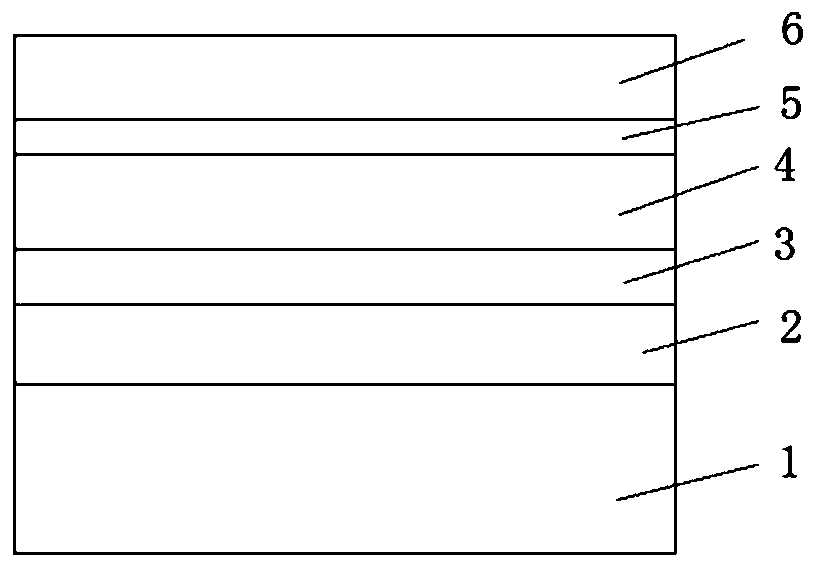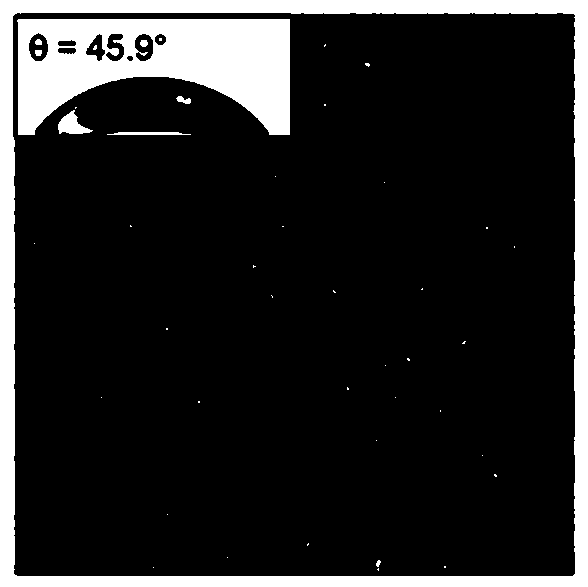Organic/inorganic gradient diffusion interface layer-based organic photovoltaic cell and preparation method thereof
A technology of organic photovoltaic cells and gradient diffusion, applied in photovoltaic power generation, semiconductor/solid-state device manufacturing, circuits, etc., can solve the problems of conflict, pollution and sustainable development of energy consumption, and achieve the promotion of improving and reducing the probability of charge capture , Improve the effect of photoelectric conversion efficiency
- Summary
- Abstract
- Description
- Claims
- Application Information
AI Technical Summary
Problems solved by technology
Method used
Image
Examples
Embodiment 1
[0036]The organic photovoltaic cell based on the organic / inorganic gradient diffusion interface layer in this embodiment includes: from bottom to top, it includes a transparent substrate layer, a metal cathode layer, a gradient diffusion composite interface layer, an organic active layer, a hole transport layer and a metal anode layer. Among them, the material of the transparent substrate layer is transparent glass; the material of the metal cathode layer is Al; the material of the gradient diffusion composite interface layer includes zinc oxide and non-fullerene derivative ITIC; the material of the organic active layer is thiophene with a mass ratio of 2:3 Similar materials PTB7-Th and fullerene derivatives PC 71 BM; the material of the hole transport layer is MoO 3 ; The material of the metal anode layer is indium tin oxide.
[0037] The thickness of the transparent substrate layer of the organic photovoltaic cell is 1-1.5 cm, the thickness of the metal cathode layer is 80-...
Embodiment 2
[0065] Single dimensional test of embodiment 2 organic semiconductor material
[0066] The basic steps are the same as in Example 1, except that the organic semiconductor materials are respectively selected from small molecules of fullerene derivatives (PC 71 BM), non-fullerene derivative small molecule (ITIC) and organic bipolar molecule (DNcZPS), the organic photovoltaic cell prepared by this embodiment is tested for performance, and the obtained results are as follows Figure 7 shown. It can be seen from the figure that the opening voltage of organic photovoltaic cells is 0.81V, the fill factors are 0.60, 0.66, 0.61 and 0.61, and the efficiencies are 7.88%, 8.73%, 7.93% and 8.00%, respectively. layer, it is beneficial to improve the interfacial contact between the inorganic interface and the organic active layer.
Embodiment 3
[0067] The single-dimensional experiment of embodiment 3 organic semiconductor material concentration
[0068] The basic steps are the same as in Example 1, except that the solubility of the organic semiconductor molecular solution is 0.5mg / mL, 1.0mg / mL and 2.0mg / mL respectively, and the performance of the organic photovoltaic cell prepared in this example is tested , the obtained results are as follows Figure 8 shown. It can be seen from the figure that the opening voltage of the devices is 0.81V, the fill factors are 0.60, 0.63, 0.66 and 0.63, and the efficiencies are 7.88%, 8.11%, 8.73% and 8.23%. When the concentration of the doped organic semiconductor molecule solution is 1mg / ml, the organic photovoltaic device exhibits a relatively good fill factor and photoelectric conversion efficiency. The XPS test data of the organic / inorganic gradient diffusion interface prepared by zinc oxide and the optimal concentration of 1.0mg / ml and its etching for 10s are as follows: Fi...
PUM
| Property | Measurement | Unit |
|---|---|---|
| Thickness | aaaaa | aaaaa |
| Thickness | aaaaa | aaaaa |
| Thickness | aaaaa | aaaaa |
Abstract
Description
Claims
Application Information
 Login to View More
Login to View More - R&D
- Intellectual Property
- Life Sciences
- Materials
- Tech Scout
- Unparalleled Data Quality
- Higher Quality Content
- 60% Fewer Hallucinations
Browse by: Latest US Patents, China's latest patents, Technical Efficacy Thesaurus, Application Domain, Technology Topic, Popular Technical Reports.
© 2025 PatSnap. All rights reserved.Legal|Privacy policy|Modern Slavery Act Transparency Statement|Sitemap|About US| Contact US: help@patsnap.com



